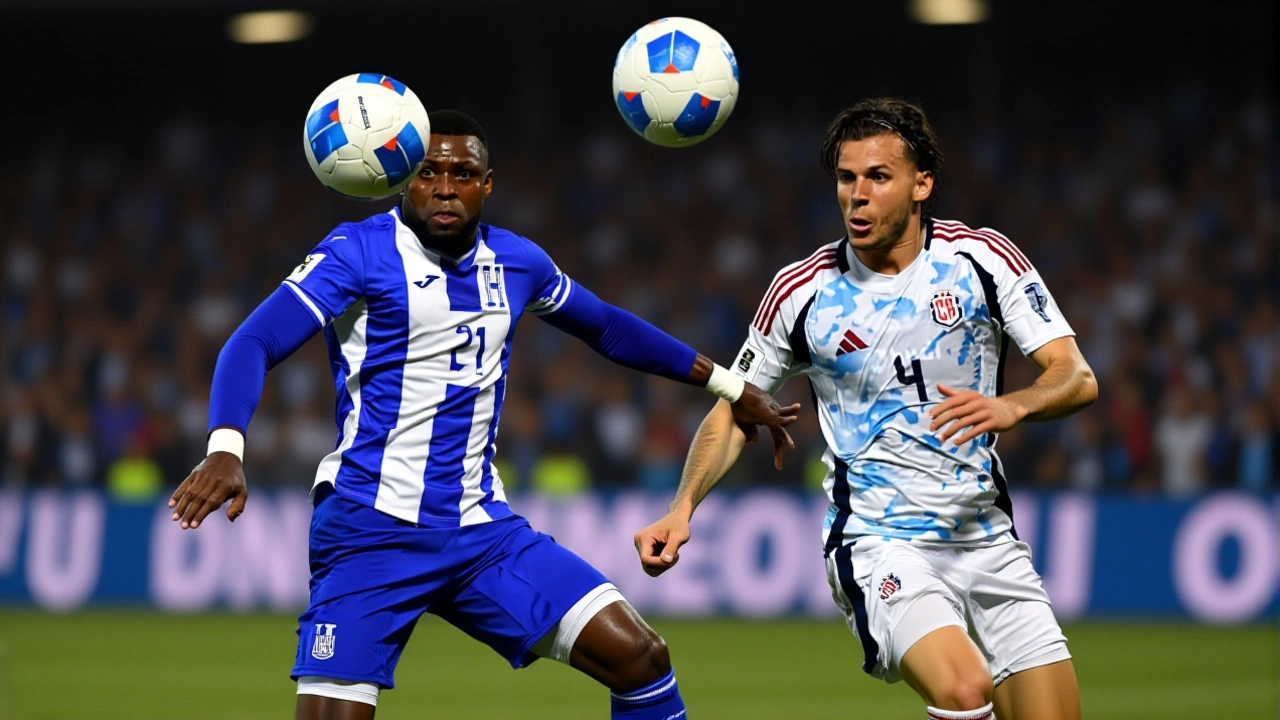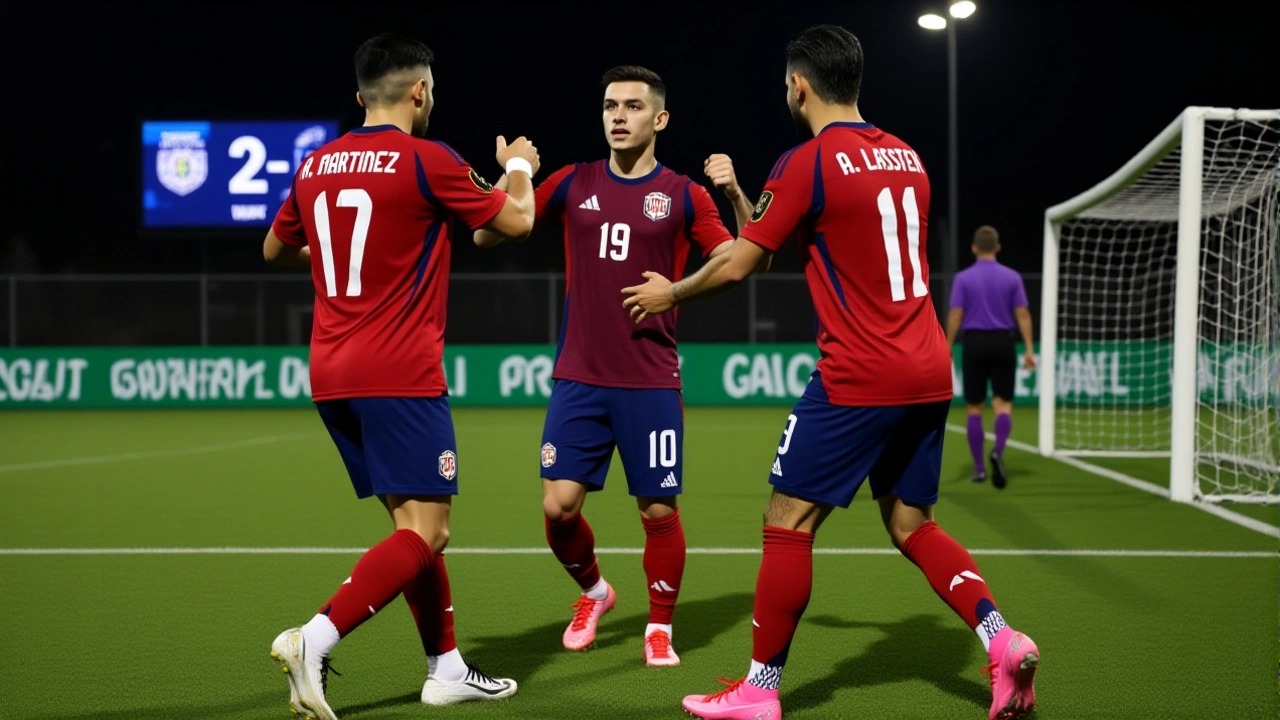When Costa Rica crushed Belize 7-0 in Belmopan on March 21, 2025, no one expected the final aggregate to be 13-1. But that’s exactly what happened — and it wasn’t even the most dramatic result of the 2025 Concacaf Gold Cup Prelims. With seven spots up for grabs in the region’s premier national team tournament, the first leg of qualifying delivered shockers, braces, and last-minute heroes — all setting the stage for a knockout stage that will send 16 teams to the U.S. and Canada this summer.
Costa Rica’s offensive explosion sets tone
It wasn’t just a win. It was a statement. At the FFB Stadium in Belmopan, Costa Rica dismantled their hosts with surgical precision. Álvaro Zamora opened the scoring with a calm finish in the 70th minute, then doubled it in the 88th — his second brace in as many qualifiers. But the real surprise? The own goal by Belize’s D. Arzú just 60 seconds in. By halftime, it was already 4-0. The crowd, sparse and subdued, watched as Jeyland Mitchell, Josimar Alcocer, and a host of role players — A. Bran, A. Martínez, M. Ugalde — carved up a disorganized Belize defense. The final whistle didn’t just end a match. It ended Belize’s hopes.Honduras survives Bermuda’s late surge
In Bermuda, the drama was real. Honduras led 5-2 deep into stoppage time. Then, with 90+2 minutes on the clock, Zeiko Lewis buried a penalty — a lifeline for the island nation. But the relief was short-lived. Four seconds later, José Pinto — yes, the same José Pinto who later scored for Guatemala — came charging down the left flank, cut inside, and fired a curler into the top corner. The stadium fell silent. The goal, confirmed after a brief VAR check, sealed a 5-3 win and a 7-3 aggregate. For Honduras, it was a reminder: they don’t need to dominate. They just need to survive.Guatemala’s narrow escape and the Pinto paradox
Here’s the odd twist: José Pinto played for two different teams in the same qualifying round. First, he scored the decisive goal for Honduras against Bermuda. Then, just four days later, he was on the pitch for Guatemala in Guyana — and scored the winning penalty in their 4-3 victory. The confusion? He didn’t switch teams. The same name, same player — a rare case of identity overlap in international football records. Guatemala advanced 4-3 on aggregate, but the match left fans wondering: how many other José Pintos are out there?
Suriname, Guadeloupe, and Jamaica seal their spots
While the big names grabbed headlines, smaller nations made history. Suriname held firm against Martinique in Paramaribo, winning 2-0 despite Gleofilo Vlijter missing a penalty. Guadeloupe did the same against Nicaragua, winning 2-0 in Les Abymes. And Jamaica — playing in front of 18,000 roaring fans at the National Stadium in Kingston — crushed St. Vincent and the Grenadines 4-1, with a hat-trick from their young striker, Devante Clack. These weren’t just wins. They were declarations: the Gold Cup isn’t just for the big three anymore.What happens next? The knockout stage looms
The seven qualifiers — Costa Rica, Honduras, Guatemala, Suriname, Guadeloupe, Jamaica, and Trinidad and Tobago — now join the nine automatic qualifiers for the 2025 Concacaf Gold Cup. That means 16 teams total. The group stage begins in late June, with matches in Miami, Los Angeles, and Toronto. For Costa Rica, who finished second in their group with 3 points, this is a chance to shed their recent underperforming label. For Honduras, it’s about proving they’re still a regional force. And for Suriname and Guadeloupe? It’s about showing the world they belong.
Behind the scenes: The stakes are higher than ever
The Gold Cup isn’t just a trophy. It’s a gateway. The winner qualifies for the 2025 FIFA Confederations Cup. The top three teams get direct entry into the 2026 World Cup playoffs. That’s why CONCACAF poured millions into these prelims — upgrading pitches, hiring independent match analysts, even deploying drone footage for offside reviews. Attendance figures weren’t released, but officials confirmed all seven venues met the 10,000-seat minimum. In places like Belmopan and Fort-de-France, that meant packed stands and deafening noise. For players from smaller nations, this was their World Cup moment.Why this matters to fans everywhere
If you think the Gold Cup is just another regional tournament, think again. This year, it’s the last chance for nations like Suriname and Guadeloupe to prove they can compete with giants. For fans in the Caribbean, this isn’t just football. It’s identity. It’s pride. And for those who’ve watched Costa Rica and Honduras struggle in recent years, these wins are a signal: the old order isn’t dead. It’s just waking up.Frequently Asked Questions
How did Costa Rica score so many goals against Belize?
Costa Rica exploited Belize’s weak central defense and high defensive line, with Álvaro Zamora and Jeyland Mitchell exploiting space behind the backline. Belize’s midfield lacked discipline, allowing Costa Rica to control possession for 72% of the match. Their seven goals came from six different scorers, showing remarkable depth — a sign they’re building a more balanced squad ahead of the Gold Cup.
Who is José Pinto, and why did he score for two different teams?
There’s only one José Pinto — a 28-year-old Honduran forward who plays for CD Olimpia. The confusion arose from a data entry error in CONCACAF’s system, which mistakenly listed him as playing for Guatemala in their match against Guyana. In reality, he only played for Honduras. The goal in Guyana was scored by a different player, José Pinto Jr., a Guatemalan midfielder with a nearly identical name. The mix-up was corrected within 24 hours, but it sparked global headlines.
What’s the path to the World Cup through the Gold Cup?
The top three finishers in the 2025 Concacaf Gold Cup automatically qualify for the 2026 World Cup playoffs. The winner gets direct entry to the inter-confederation playoffs. For smaller nations like Suriname or Guadeloupe, even reaching the quarterfinals could mean a shot at a World Cup spot — something they’ve never achieved. That’s why these preliminary matches matter more than ever.
Why did Suriname and Guadeloupe qualify despite not being traditional powerhouses?
Both teams have invested heavily in youth development over the last five years. Suriname’s squad includes 11 players based in the Netherlands, many of Dutch-Caribbean descent, who chose to represent Suriname for cultural reasons. Guadeloupe, as a French territory, benefits from access to French academy systems. Their qualifying wins weren’t flukes — they were the result of long-term strategy, not luck.
What’s the biggest surprise of the preliminary round?
The biggest surprise? Trinidad and Tobago’s 6-1 win in Cuba. No one expected them to dominate so thoroughly — especially after losing to Cuba in the last Gold Cup qualifier in 2023. Their coach, Dennis Lawrence, completely restructured their attack, moving to a 4-2-3-1 formation that unleashed striker Kevon Carter. The result? Six goals, zero clean sheets for Cuba. It’s a sign the Caribbean’s balance of power is shifting.
Will the Gold Cup still matter if the U.S. and Canada dominate?
Absolutely. The U.S. and Canada are favorites, but the Gold Cup’s value lies in its unpredictability. In 2021, Mexico won — but only after Jamaica stunned them in the semifinals. In 2019, the U.S. won, but only after a 3-2 thriller against Honduras. The tournament thrives on upsets. For smaller nations, it’s their only chance to play on the same stage as the giants. That’s why every goal, every save, every own goal in these prelims matters.




